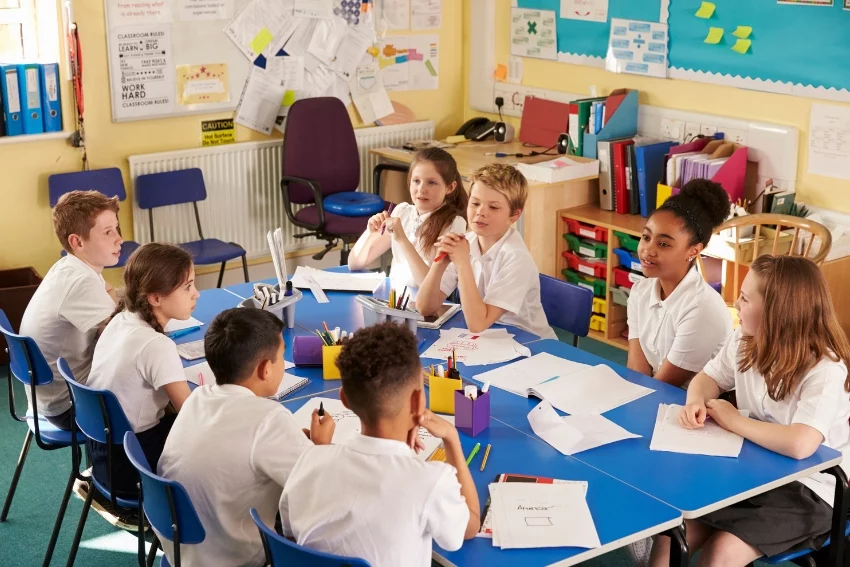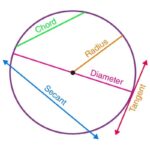Table of Contents:
What are Private Schools?
Private schools in the UK are educational institutions that charge fees for attendance, as opposed to state-funded schools which are free. These schools are also commonly known as independent schools, as they are not affiliated with the state and have their own governing bodies.
Private schools often have smaller class sizes, more resources and facilities, and a greater degree of academic and extracurricular opportunities than state schools. They may also have greater autonomy in setting their own curriculum, admissions policies, and management practices. Private schools can range from small preparatory schools to large, prestigious institutions that cater to a wide range of ages and abilities.
While private schools are sometimes criticised for being elitist and perpetuating social inequality, they can also provide students with a high-quality education that prepares them well for further study and future careers. Private schools in the UK have a long and storied history, and many of them are highly respected both domestically and internationally.
Read more here – guide to choosing a secondary school in the UK.
Is the Public School the Same as the Private School?
In England, private schools are sometimes called public schools because of historical reasons. The term “public school” emerged in the 18th century when a small group of elite, fee-paying schools distinguished themselves from the free grammar schools. These schools were Eton College, Shrewsbury School, Harrow School, Charterhouse School, Rugby School, Westminster School, and Winchester College. Over time, the term “public school” became synonymous with these exclusive institutions.
Despite the confusing terminology, “public schools” in England are not actually public in the sense that they are state-funded. They are private schools that charge fees for attendance. Today, the term “public school” is considered outdated, and these schools are typically referred to as “private schools” or “independent schools.”
What are the Differences Between State Schools and Private Schools?
There are several key differences between private schools and state schools in the UK:
📌 Funding. State schools are funded by the government, whereas private schools are funded by tuition fees paid by parents, investments, and donations. This means that private schools have greater control over their budget and can offer more resources and facilities.
📌 Admissions. State schools are open to all children, while private schools have selective admissions processes based on academic ability, interviews, and other factors. Private schools may also require students to pass an entrance exam or assessment.
📌 Class sizes. Private schools typically have smaller class sizes than state schools, which can allow for more individual attention and a more personalised education experience.
📌 Curriculum. Private schools are not bound by the national curriculum, and may offer a wider range of subjects or focus on specific areas of study. State schools must follow the national curriculum and may have less flexibility in terms of curriculum design.
📌 Culture. Private schools often have a distinct culture and ethos, which can vary depending on the school’s history, traditions, and values. State schools, on the other hand, are typically more diverse and may have a broader range of cultures and backgrounds represented among their students.
What are Grammar Schools?
Grammar schools are a type of state-funded secondary schools in the UK that select their students based on academic ability, usually measured through a standardized test known as the 11-plus. The term “grammar” refers to the historical role of these schools in teaching classical languages and literature, but nowadays their curriculum is similar to that of other state schools, with a focus on academic subjects such as mathematics, sciences, English, and humanities.
Grammar schools have a long history in the UK, dating back to the 16th century, but their popularity has fluctuated over time. At their peak in the 1960s, around a quarter of all secondary school pupils attended grammar schools, but since then their numbers have declined as comprehensive schools, which do not select pupils based on ability, became the norm. Today, around 5% of state-funded secondary schools in England are grammar schools, mostly concentrated in rural and suburban areas.
Proponents of grammar schools argue that they offer high-quality education and opportunities for social mobility to bright students from disadvantaged backgrounds, who might not otherwise have access to the best schools. However, critics argue that the 11-plus test can be biased against certain groups, such as students from poorer families or those with English as a second language, and that grammar schools can exacerbate social inequalities by segregating pupils based on academic ability.
What are the Top 10 Private Schools in the UK?
1. St Paul’s Girls’ School
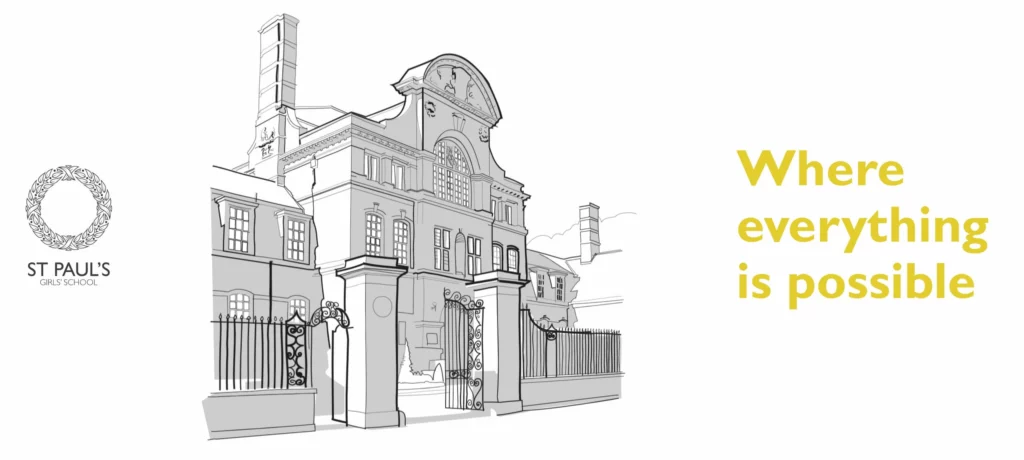
St. Paul’s Girls’ School is a prestigious independent day school in Hammersmith, West London, for girls aged 11 to 18. Founded in 1904, it is consistently ranked among the top three independent schools in England, with impressive exam results: just under 98% of A-levels were graded A*–B in 2021, while over 99% of all GCSEs were awarded the top marks of A*/A/9/8/7. The school places individual research, discussion, and debate at the heart of its teaching, with a classical yet forward-thinking approach. The school offers a range of activities and initiatives, including the St. Paul’s Programme and Friday Lectures, to broaden the horizons of students. The co-curricular program offers opportunities in music, drama, sport, and STEM, and there are charitable opportunities through community and enrichment projects. The school has a competitive admission process, with registration closing on November 11th, 2022, and a means-tested bursary program to ensure that education is accessible to all. The school fee per term for the academic year 2022-23 is £9,264, and term dates for 2022-23 and 2023-24 are provided on the school’s website.
2. St Paul’s School
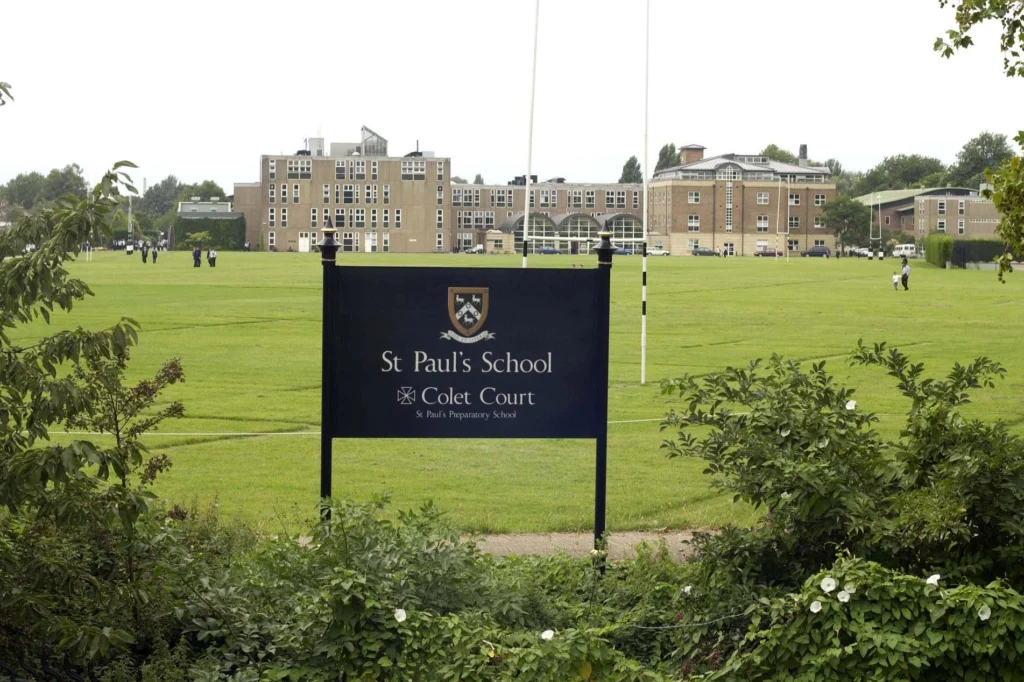
St Paul’s School is a leading independent school in the UK that provides a prestigious education to boys aged 7-18. Founded in 1590 by John Colet, the school is located on a 45-acre site by the River Thames in Barnes, South West London, and boasts exceptional facilities. St Paul’s is renowned for its outstanding academic results, with 94% of GCSE grades being 8 or 9 and 95% of A level results being A* or A in 2021. 80% of pupils go on to top UK universities and 13% to North American universities each year. There are five entry points to the school, with Year 7 and Year 9 being the focus of this guide. The admissions process for Year 7 involves an ISEB online pre-test, the school’s own exams, and an interview, while the selection procedure for Year 9 requires an ISEB online pre-test, a headteacher’s report, the school’s own exams, and an interview. The school also offers scholarships and financial assistance to families with household incomes of less than £120,000 per annum.
3. King’s College School Wimbledon
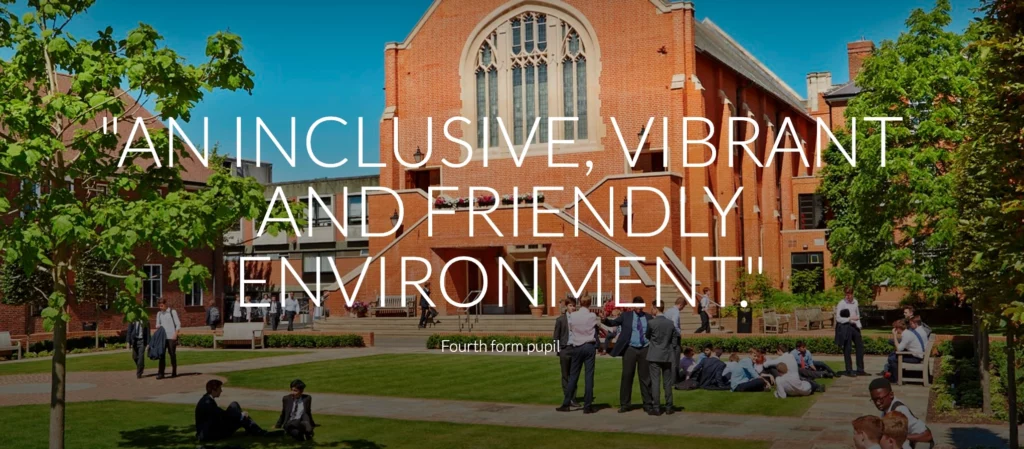
King’s College School Wimbledon is a highly regarded independent day school for boys aged 11-18 and girls aged 16-18, located on Wimbledon Common in South West London. The school’s prep school, King’s College Junior School, is situated on the same site. Founded in 1829 by royal charter as the junior department of King’s College London, the school separated constitutionally from the university in 1908 and relocated to Wimbledon in 1897. The senior school consistently ranks highly in exam league tables and was named ‘Top boys or co-ed independent school’ by The Sunday Times for the third consecutive year in 2020. Students consistently achieve outstanding results, with 94.9% of A level grades being A*/A/B and 96.3% of GCSE grades being A*/A/9/8/7 in 2019. Sixth form students can also choose to take the International Baccalaureate, with a mean point score of 40.75 out of 45 compared to the international average of 33.2.
King’s College School offers a diverse co-curricular programme, and pupils benefit from extended lunch breaks and no timetabled subjects on Friday afternoons. The school also has an extensive partnerships and outreach programme, consisting of the Wimbledon independent state-schools partnership, arrangements with over 20 other maintained schools, and weekly projects within the local community.
Dr. Anne Cotton will become Headteacher of King’s College School in September 2022. The school admits 60 external applicants to Year 7, in addition to boys moving up from King’s College Junior School. The admissions process involves an entrance exam, interview, headteacher’s reference, and Year 5 school report. The ratio of applicants to places is 8:1, and registration opens on April 21st, 2022, and closes on October 31st, 2022. The assessment date for Year 7 entry is Saturday, December 3rd, 2022. Means-tested bursaries are offered, covering up to 100% of tuition fees, and scholarships are available for academic, music, and sports excellence.
Term dates for King’s College School are from September 1st to July 3rd, with Autumn and Spring terms divided into half terms. The provisional term dates for 2023-24 are as follows: Autumn term from September 1st to December 14th, 2023, with a half-term break from October 16th to October 27th, 2023. Spring term from January 9th to March 26th, 2024, with a half-term break from February 12th to February 16th, 2024. Finally, Summer term from April 17th to July 3rd, 2024, with a half-term break from May 27th to May 31st, 2024.
If you are interested in applying for your son to attend King’s College School, you must complete an online registration form by October 31st, 2022. The application process includes an entrance exam, interview, headteacher’s reference, and Year 5 school report. Additionally, the school offers means-tested bursaries and scholarships for academic, music, and sports excellence. The entrance exam is on December 3rd, 2022, and all boys are automatically considered for an academic scholarship. More information is available on the school’s website.
4. The Godolphin and Latymer School

The Godolphin and Latymer School is a highly regarded private day school for girls aged 11-18, located in the Hammersmith area of West London. The school boasts an outstanding reputation for providing exceptional academic and extracurricular opportunities, making it an ideal choice for families seeking the best education for their daughters. In 2020, the school was named the Sunday Times Independent Secondary School of the Year, a testament to its commitment to excellence.
At Godolphin and Latymer, tuition fees are currently set at £8,395 per term. However, the school recognizes that some families may require financial assistance, and therefore offers means-tested bursaries ranging from 10% to 100% of school fees, including fully funded places, for eligible 11 plus and 16 plus applicants. Additionally, students applying for entry in Year 7 have the opportunity to apply for a music scholarship, which includes 30% fee remission and free music lessons for one or two instruments.
Overall, The Godolphin and Latymer School provides a supportive and enriching environment for girls to thrive academically, socially, and personally, and is a top choice for families seeking a first-rate education for their daughters.
5. Guildford High School

Guildford High School, founded in 1888, is a prestigious independent day school located in Guildford, Surrey. The school provides a first-class education to approximately 1,000 girls aged 7-18, nurturing them to become independent, confident, and well-rounded individuals.
Guildford High School has been recognized for its excellence in education, being named the ‘South East Independent Secondary School of the Decade’ by The Sunday Times in 2021. The school prides itself on offering a rich and diverse curriculum, encompassing a wide range of subjects from humanities and sciences to arts and music.
The fees for Guildford High School for the academic year 2022-23 are £6,405 per term. The school offers a sibling discount of 5% and 10% for subsequent daughters, making it easier for families with multiple children to provide an exceptional education to their daughters. The school also provides means-tested bursaries to eligible families, ensuring that the school’s excellent education is accessible to girls from all backgrounds.
For students who excel in academics or music, academic and music scholarships are available, which can be worth up to 5% off the school fees. These scholarships are awarded based on assessment and provide an opportunity for talented students to develop their skills and reach their full potential.
6. Sevenoaks School
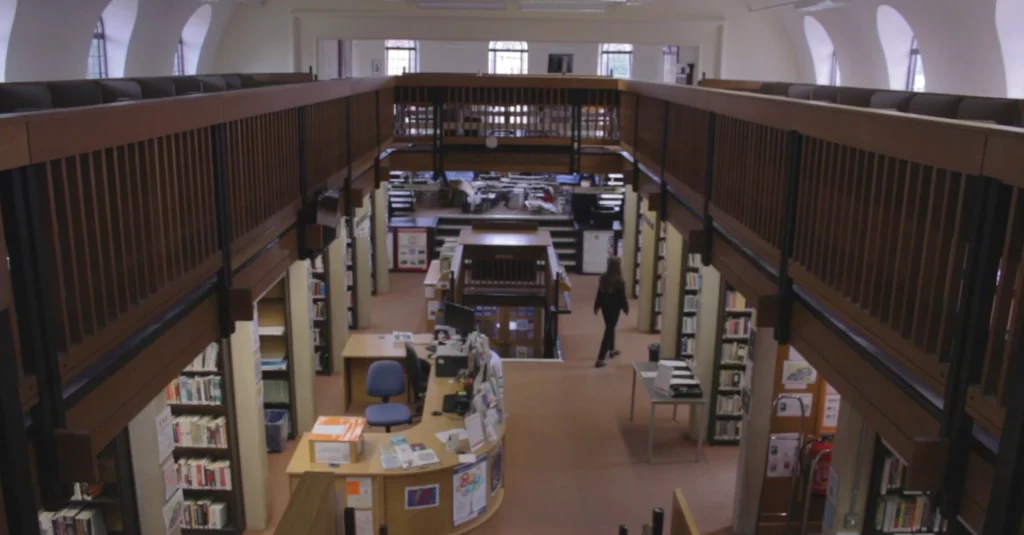
Sevenoaks School is an independent day and boarding school in Sevenoaks, Kent. Founded in 1432, the school provides co-educational education for students aged 11 to 18. The school’s 100-acre campus is located in the Kent countryside, only 30 minutes from central London and Gatwick international airport. With a global outlook, the student body is made up of approximately 46 nationalities, offering a cosmopolitan mix of cultures. Sevenoaks School has received numerous accolades, including ‘Independent School of the Year’ in 2008 and 2018, ‘Top Independent IB Boarding School’ (2018), and ‘Top Fully Co-Educational IB School in the UK.’ The school is known for its rigorous, rewarding, and supportive education, adopting the International Baccalaureate (IB) in the sixth form in 1978. In 2022, the average IB Diploma score was 40.1 points, with 61% of the cohort achieving 40 points or more, placing the school within the top 10 private schools in England. The student’s activities and interests are not limited, with numerous opportunities in music, sport, art, drama, CCF, DofE, clubs, and expeditions. All pupils are expected to participate in service activities as part of the school’s approach to service and social impact. The school has a strict selection process for admission, with a school’s exam, reference, and group interview for both 11 and 13 plus entry. Financial assistance is available to eligible families for day pupils who can receive up to 110% of the day fees, which includes funds to cover trips, uniforms, and other extras alongside daily tuition. The term dates for 2022-23 are Autumn term (Michaelmas): 2nd September – 13th December 2022, Spring term (Lent): 6th January – 24th March 2023, and Summer term: 19th April – 30th June 2023.
7. Westminster School
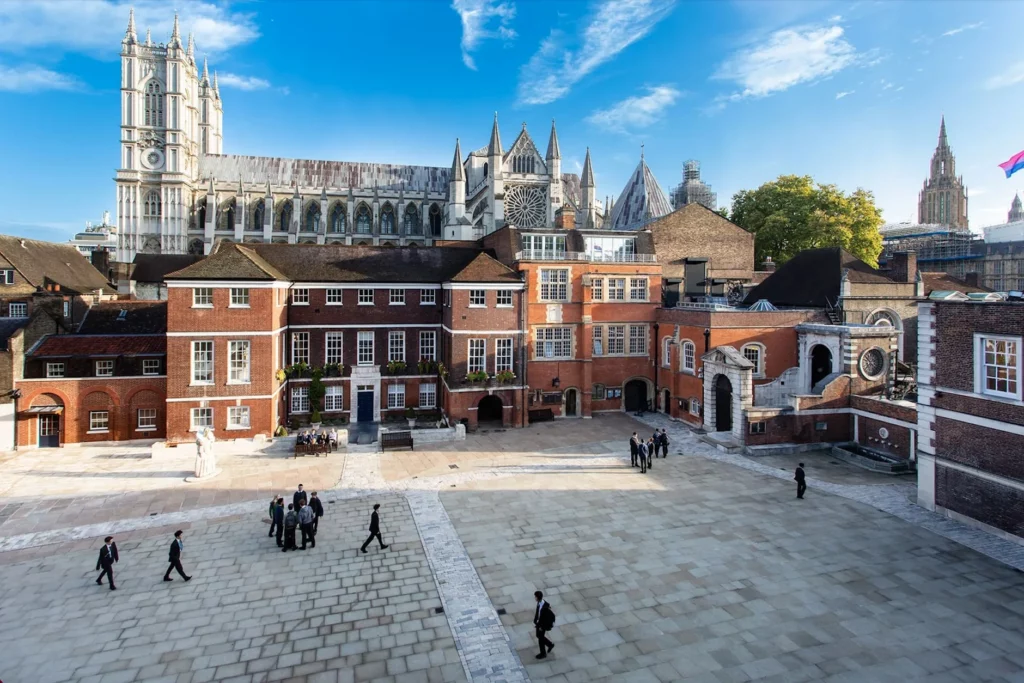
Westminster School is a distinguished independent day and boarding school located in the City of Westminster, London. The school caters to boys aged 13-18 with a co-educational sixth form. The Great School, as it is commonly referred to, is one of the top 10 private schools in England, renowned for academic excellence and its long-standing history dating back to the 14th century. The school’s location next to Westminster Abbey and the Houses of Parliament adds to its prestige and rich cultural heritage.
The school’s curriculum combines traditional academic subjects with innovative options such as theology and philosophy, electronics, product design, and languages like Mandarin and Russian. The Great School aims to foster a love for learning and encourage students to embrace fresh ideas. Three core objectives underpin the school’s education, which are transforming lives, transforming experience, and transforming impact. The school is committed to these objectives by widening access, increasing diversity and inclusion, and working with global partners to develop a community of well-rounded scholars who care deeply about the life of the mind and the lives of others.
Westminster School has a proven track record of academic excellence with outstanding results at both GCSE and A-level. In 2019, 95% of all GCSE grades were 9 or 8 (A* equivalent), while 76% of A-level grades were A*–A. Graduates from Westminster School are highly sought after and are accepted at leading universities globally. American universities are increasingly popular destinations for Westminster students with approximately 40 places offered each year in leading fields at renowned institutions such as London School of Economics, Imperial College, Sorbonne, and New York Film School, among others.
The school has a registration process that involves an ISEB Common Pre-Test, the school’s own test, school reference, and an interview. Westminster School offers financial assistance to pupils across the Under School (prep) and Great School (senior), and children living within the M25 London orbital and can commute daily to school are eligible for a means-tested bursary. The current fees at Westminster School are £9,987 per term (£29,961 per year) for day pupils and £14,424 per term (£43,272 per year) for boarding pupils.
In addition to academic scholarships, Music Scholarships and Organ Scholarships are available for boys at 13 plus entry. Successful candidates known as Queen’s Scholars are required to board at Westminster School but pay the day fee rather than the full boarding fee. The term dates for Westminster School are structured into three terms – Play (autumn), Lent (spring), and Election (summer), with breaks during half-term and exeat weekends. The school also provides regular tours available for 13 plus entry to help prospective parents and pupils.
Westminster School has a proud history of transforming lives through education and instilling the love for learning in pupils. Its location, academic excellence, and commitment to diversity and inclusion make it an ideal choice for parents looking for a well-rounded education for their children.
8. Tonbridge School
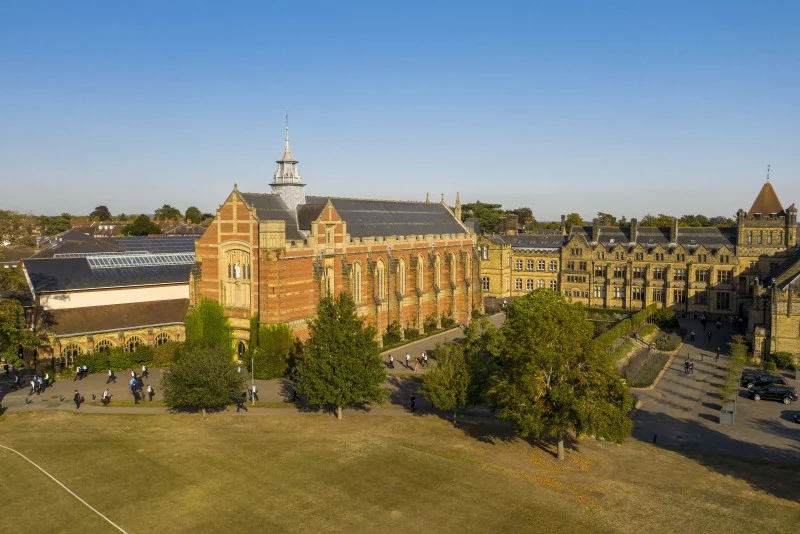
Tonbridge School is a prestigious day and boarding school for boys aged 13-18, located in Tonbridge, Kent. The school has a rich history dating back to 1553 and occupies a sprawling 150-acre site that blends both contemporary and traditional architecture. Tonbridge School is one of the few remaining single-sex boarding schools in the UK. Its motto, “Only Connect,” is inspired by E.M. Forster, an alum of the school. The institution aims to foster creativity, confidence, and compassion in its pupils, while also expanding access to its educational programs. The school has an outstanding academic reputation and offers 26 subjects based on the skills identified by The World Economic Forum as having the most future value, including critical thinking, resilience, and complex problem-solving. Tonbridge School’s academic excellence is evident in the exam results, with more than 85% of A levels and 97% of GCSEs graded A*, A or equivalent in 2022. Tonbridge School also has a strong commitment to community and outreach, with partnerships with local primary schools, secondary schools, special schools, and charitable organizations across Kent. In 2021, Tonbridge School merged with The New Beacon Prep School to expand access to senior school facilities and staff. The school has 800 pupils and is led by Mr. James Priory. The school’s selection procedure includes an ISEB Common Pre-Test and school assessment, school reference, and school report. Tonbridge School offers means-tested financial assistance to boys with outstanding academic potential and who show musical talent, with fees ranging from £11,689 for day pupils to £15,580 for boarding pupils. In addition, Tonbridge School provides scholarships to boys in Year 8 to support academic, art, design, technology, engineering, drama, music, and sport excellence. The school also offers term dates from September to July, with breaks during autumn, spring, and summer.
9. Brighton College
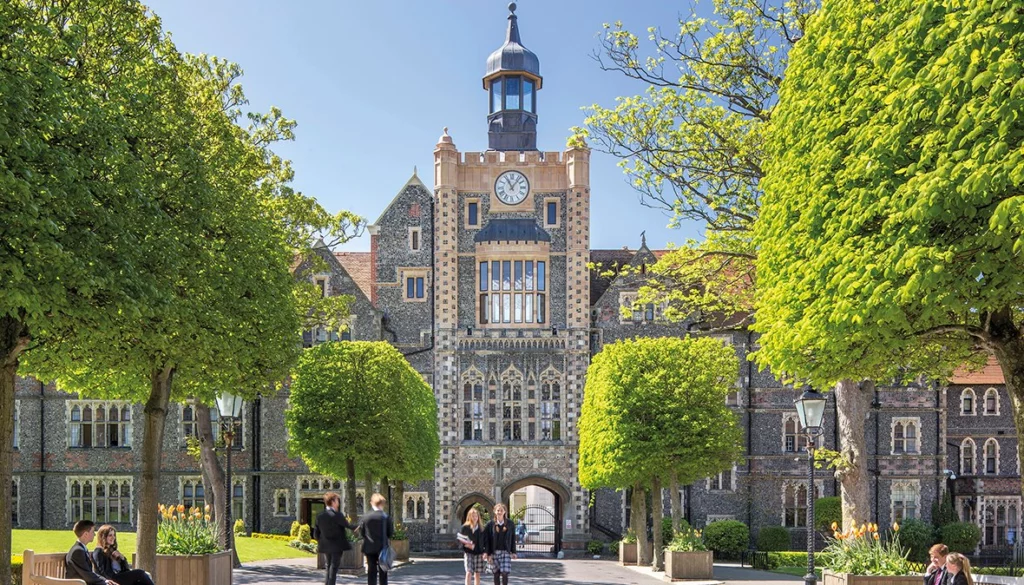
Brighton College is a prestigious independent school located in the coastal city of Brighton, in East Sussex, England. Founded in 1845, the school has a long and rich history of providing excellent education to both boys and girls aged 11 to 18. In 2021, Brighton College was awarded the title of ‘United Kingdom School of the Decade’ by The Sunday Times, in recognition of its culture of kindness and transformative leadership. Richard Cairns, the current headmaster, was also recognized in The Sunday Times 2021 survey for his outstanding leadership in the past decade.
Brighton College is renowned for its focus on pastoral care and wellbeing, which is at the heart of school life. The school assigns all pupils to a house, where students of all ages mix together, and older students mentor younger ones. The school’s well-being initiatives include weekly mindfulness classes, meditation workshops, and yoga classes.
The curriculum at Brighton College is extensive, and the school’s focus is on preparing students for 21st-century life. Students in Years 7 and 8 are required to learn Mandarin Chinese, and the school offers a further five languages to choose from, with IT and coding embedded in the timetable. Exam results at Brighton College are consistently strong, with the school placing in the top 10 private schools in England. In 2020, 96% of GCSE grades were 9-7/A*/A and 99% of A level grades were A*–B.
Beyond the classroom, Brighton College offers a wide range of opportunities in sports and the arts. The school is one of the leading sporting schools in the country and in 2020 it opened a new School of Science and Sport, which offers a double-height sports hall, rooftop running track, and 25-metre swimming pool. Meanwhile, the school calendar is full of a range of music, dance, art, and drama events, including annual musical and pupil-directed plays.
The school has two entry points: 11 plus (Year 7) and 13 plus (Year 9). The main entry point is at 13 plus, while the 11 plus entry is for students joining the lower school. The admissions process involves a school-specific exam and interview for 11 plus entry and the ISEB Pre-Test, a school-specific exam, and interviews for 13 plus entry. Brighton College also offers means-tested bursaries and scholarships to students who show exceptional academic or artistic talent.
The termly tuition fees for Year 7 pupils at Brighton College are £6,830 from 2022. Day fees are currently £8,950 for 13 plus entry, while boarding fees range from £12,960 to £18,250 (UK weekly boarding to overseas full boarding). Means-tested bursaries are available for day places only.
10. North London Collegiate School
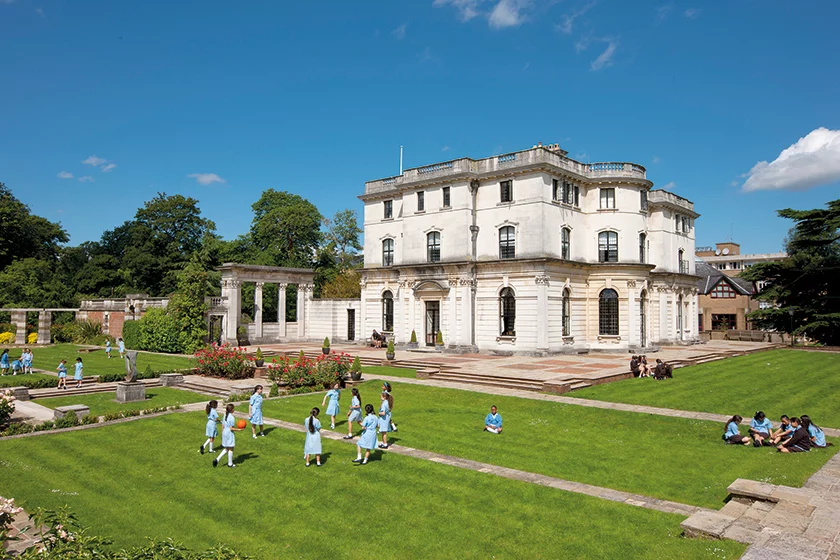
North London Collegiate School is a prestigious independent day school exclusively for girls, ranging from ages 4 to 18. The school was established in 1850 by Frances Buss, a visionary leader in the field of girls’ education, who championed equal opportunities for girls in education. The institution is renowned for its excellent academic standards and its commitment to empowering girls with the tools and skills necessary to succeed in life.
The school is situated on a picturesque 30-acre campus in Edgware, a suburban area in North West London. Its stunning Georgian mansion building has been beautifully refurbished to create a modern learning environment, with state-of-the-art facilities that enable students to explore their interests and talents.
The school prides itself on its diverse community, where girls from different backgrounds and cultures come together to learn and grow. To make education accessible to all, the school offers means-tested bursaries of up to 100% fee remission for eligible 11 plus and 16 plus candidates. Currently, around 9% of the pupils receive means-tested support. The Handel Music Scholarships provide an opportunity for musically gifted students to receive an annual financial award equivalent to the cost of individual music lessons in two instruments, valued at approximately £1,590.
Top 100 Private Schools in the UK
1. St Paul’s Girls’ School (West London)
Girls | A level: 99.5% A*–B | GCSE: 97.9% A*/A/9/8/7
2. St Paul’s School (South West London)
Boys | A level: 98.8% A*–B | GCSE: 98.9% A*/A/9/8/7
3. King’s College School, Wimbledon (South West London)
Boys, mixed sixth form | A level: 99.3% A*–B | GCSE: 97.7% A*/A/9/8/7
4. The Godolphin and Latymer School (West London)
Girls | A level: 98% A*–B | GCSE: 98.3% A*/A/9/8/7
5. Guildford High School (Surrey)
Girls | A level: 98.3% A*–B | GCSE: 97.2% A*/A/9/8/7
6. Sevenoaks School (Kent)
Boys & girls | A level: 98.7% A*–B | GCSE: 96% A*/A/9/8/7
7. Westminster School (Central London)
Boys, mixed sixth form | A level: 97.5% A*–B | GCSE: 98% A*/A/9/8/7
8. Tonbridge School (Kent)
Boys | A level: 97.8% A*–B | GCSE: 97.3% A*/A/9/8/7
9. Brighton College (Brighton)
Boys & girls | A level: 98.4% A*–B | GCSE: 93.8% A*/A/9/8/7
10. North London Collegiate School (North London)
Girls | A level: 97.2% A*–B | GCSE: 96% A*/A/9/8/7
11. City of London School (Central London)
Boys | A level: 96.6% A*–B | GCSE: 96.8% A*/A/9/8/7
12. Wycombe Abbey School (Buckinghamshire)
Girls | A level: 96.8% A*–B | GCSE: 96.4% A*/A/9/8/7
13. Francis Holland School, Sloane Square (West London)
Girls | A level: 94.5% A*–B | GCSE: 98.7% A*/A/9/8/7
14. City of London School for Girls (Central London)
Girls | A level: 94.5% A*–B | GCSE: 98.7% A*/A/9/8/7
15. King Edward VI High School for Girls (Birmingham)
Girls | A level: 96.4% A*–B | GCSE: 94.9% A*/A/9/8/7
16. Cardiff Sixth Form College (Cardiff)
Boys & girls | A level: 99.2% A*–B | GCSE: 88.8% A*/A/9/8/7
17. Hampton School (South West London)
Boys | A level: 95.9% A*–B | GCSE: 95.4% A*/A/9/8/7
18. Magdalen College School (Oxford)
Boys, mixed sixth form | A level: 96.9% A*–B | GCSE: 93% A*/A/9/8/7
19. Haberdashers’ Boys’ School (Hertfordshire)
Boys | A level: 95.9% A*–B | GCSE: 94.4% A*/A/9/8/7
20. Eton College (Berkshire)
Boys | A level: 95.8% A*–B | GCSE: 94.2% A*/A/9/8/7
21. Highgate School (North London)
Boys & girls | A level: 95% A*–B | GCSE: 95.7% A*/A/9/8/7
22. Lady Eleanor Holles (South West London)
Girls | A level: 94.9% A*–B | GCSE: 95.5% A*/A/9/8/7
23. Trinity School, Croydon (South London)
Boys, mixed sixth form | A level: 96% A*–B | GCSE: 93% A*/A/9/8/7
24. The Perse School (Cambridge)
Boys & girls | A level: 95.7% A*–B | GCSE: 92.9% A*/A/9/8/7
25. Latymer Upper School (West London)
Boys & girls | A level: 94.5% A*–B | GCSE: 95.1% A*/A/9/8/7
26. Alleyn’s School (South London)
Boys & girls | A level: 95.5% A*–B | GCSE: 92.7% A*/A/9/8/7
27. University College Senior School (North London)
Boys, mixed sixth form | A level: 96.3% A*–B | GCSE: 90.8% A*/A/9/8/7
28. Dulwich College (South London)
Boys | A level: 95.1% A*–B | GCSE: 92.9% A*/A/9/8/7
29. Withington Girls’ School (Manchester)
Girls | A level: 94.9% A*–B | GCSE: 93.3% A*/A/9/8/7
30. Royal Grammar School, Guildford (Surrey)
Boys | A level: 95.1% A*–B | GCSE: 92% A*/A/9/8/7
31. St Mary’s School, Ascot (Berkshire)
Girls | A level: 93.3% A*–B | GCSE: 94.6% A*/A/9/8/7
32. King Edward’s School (Birmingham)
Boys | A level: 95.8% A*–B | GCSE: 89.4% A*/A/9/8/7
33. Merchant Taylors’ School (North West London)
Boys | A level: 94.2% A*–B | GCSE: 92.6% A*/A/9/8/7
34. Reigate Grammar School (Surrey)
Boys & girls | A level: 94.3% A*–B | GCSE: 91.7% A*/A/9/8/7
35. Wimbledon High School GDST (South West London)
Girls | A level: 94% A*–B | GCSE: 92% A*/A/9/8/7
36. South Hampstead High School GDST (North London)
Girls | A level: 92.7% A*–B | GCSE: 94.3% A*/A/9/8/7
37. Bancroft’s School (North East London)
Boys & girls | A level: 93% A*–B | GCSE: 93.5% A*/A/9/8/7
38. Cheltenham Ladies’ College (Gloucestershire)
Girls | A level: 93.6% A*–B | GCSE: 92.2% A*/A/9/8/7
39. St Catherine’s, Bramley (Surrey)
Girls | A level: 94.5% A*–B | GCSE: 90.4% A*/A/9/8/7
40. Surbiton High School (South West London)
Girls | A level: 94.6% A*–B | GCSE: 89.9% A*/A/9/8/7
41. St Albans School (Hertfordshire)
Boys, mixed sixth form | A level: 93.2% A*–B | GCSE: 92.7% A*/A/9/8/7
42. St Helen and St Katharine (Oxfordshire)
Girls | A level: 94.5% A*–B | GCSE: 89.9% A*/A/9/8/7
43. Kingston Grammar School (South West London)
Boys & girls | A level: 92.5% A*–B | GCSE: 92.2% A*/A/9/8/7
44. Oxford High School GDST (Oxford)
Girls | A level: 94.4% A*–B | GCSE: 88.1% A*/A/9/8/7
45. Notting Hill and Ealing High School GDST (West London)
Girls | A level: 92.3% A*–B | GCSE: 92.2% A*/A/9/8/7
46. St Helen’s School, Northwood (North West London)
Girls | A level: 93.9% A*–B | GCSE: 89% A*/A/9/8/7
47. Whitgift School (South London)
Boys | A level: 92.7% A*–B | GCSE: 91.3% A*/A/9/8/7
48. James Allen’s Girls’ School (South London)
Girls | A level: 92.4% A*–B | GCSE: 91.8% A*/A/9/8/7
49. St Michael’s School, Llanelli (South Wales)
Boys & girls | A level: 95.9% A*–B | GCSE: 84.4% A*/A/9/8/7
50. Winchester College (Winchester)
Boys, mixed sixth form | A level: 92.5% A*–B | GCSE: 91.2% A*/A/9/8/7
51. Wellington College (Berkshire)
Boys & girls | A level: 92.8% A*–B | GCSE: 90.4% A*/A/9/8/7
52. St Albans High School for Girls (Hertfordshire)
Girls | A level: 92.7% A*–B | GCSE: 90.5% A*/A/9/8/7
53. Queen Ethelburga’s College (York)
Boys & girls | A level: 95.9% A*–B | GCSE: 83% A*/A/9/8/7
54. Emanuel School (South West London)
Boys & girls | A level: 92.9% A*–B | GCSE: 88.7% A*/A/9/8/7
55. The Abbey School (Berkshire)
Girls | A level: 92.2% A*–B | GCSE: 90.2% A*/A/9/8/7
56. Hurstpierpoint College (East Sussex)
Boys & girls | A level: 94.8% A*–B | GCSE: 84.6% A*/A/9/8/7
57. Abingdon School (Oxfordshire)
Boys | A level: 93.5% A*–B | GCSE: 86.9% A*/A/9/8/7
58. St Swithun’s School (Winchester)
Girls | A level: 94.1% A*–B | GCSE: 85.3% A*/A/9/8/7
59. Concord College (Shrewsbury)
Boys & girls | A level: 92.6% A*–B | GCSE: 88.1% A*/A/9/8/7
60. St John’s College (Cardiff)
Boys & girls | A level: 92.6% A*–B | GCSE: 88.1% A*/A/9/8/7
61. Downe House (Berkshire)
Girls | A level: 91.7% A*–B | GCSE: 88.4% A*/A/9/8/7
62. Radley College (Oxfordshire)
Boys | A level: 92.5% A*–B | GCSE: 86.8% A*/A/9/8/7
63. Manchester High School for Girls (Manchester)
Girls | A level: 95.2% A*–B | GCSE: 80.7% A*/A/9/8/7
64. Nottingham High School (Nottingham)
Boys & girls | A level: 92.2% A*–B | GCSE: 86.2% A*/A/9/8/7
65. Putney High School GDST (South West London)
Girls | A level: 89.5% A*–B | GCSE: 91.2% A*/A/9/8/7
66. Caterham School (Surrey)
Boys & girls | A level: 90% A*–B | GCSE: 90% A*/A/9/8/7
67. King Edward’s School, Bath (Somerset)
Boys & girls | A level: 89.5% A*–B | GCSE: 90.7% A*/A/9/8/7
68. Ibstock Place School (South West London)
Boys & girls | A level: 89.6% A*–B | GCSE: 88.3% A*/A/9/8/7
69. Sir William Perkins’s School (Surrey)
Girls | A level: 90.2% A*–B | GCSE: 87.1% A*/A/9/8/7
70. Sheffield Girls’ GDST (Sheffield)
Girls | A level: 93.3% A*–B | GCSE: 80.2% A*/A/9/8/7
71. City of London Freemen’s School (Surrey)
Boys & girls | A level: 90% A*–B | GCSE: 86% A*/A/9/8/7
72. St Mary’s Calne (Wiltshire)
Girls | A level: 92% A*–B | GCSE: 82% A*/A/9/8/7
73. Royal Grammar School (Newcastle)
Boys & girls | A level: 90.2% A*–B | GCSE: 85.4% A*/A/9/8/7
74. Harrodian (South West London)
Boys & girls | A level: 94.2% A*–B | GCSE: 76.5% A*/A/9/8/7
75. Benenden School (Kent)
Girls | A level: 87.1% A*–B | GCSE: 89.3% A*/A/9/8/7
76. Canford School (Dorset)
Boys & girls | A level: 92% A*–B | GCSE: 79.6% A*/A/9/8/7
77. Francis Holland School, Regent’s Park (North London)
Girls | A level: 89.1% A*–B | GCSE: 85.4% A*/A/9/8/7
78. Leicester Grammar School (Leicester)
Boys & girls | A level: 91% A*–B | GCSE: 81.2% A*/A/9/8/7
79. Eltham College (South East London)
Boys, mixed sixth form | A level: 89% A*–B | GCSE: 85% A*/A/9/8/7
80. Redmaids’ High School (Bristol)
Girls | A level: 88% A*–B | GCSE: 86.2% A*/A/9/8/7
81. Bradford Grammar School (West Yorkshire)
Boys & girls | A level: 91.4% A*–B | GCSE: 79.4% A*/A/9/8/7
82. Ardingly College (West Sussex)
Boys & girls | A level: 91.3% A*–B | GCSE: 79.3% A*/A/9/8/7
83. Walthamstow Hall (Kent)
Girls | A level: 88.2% A*–B | GCSE: 85.5% A*/A/9/8/7
84. Channing School (North London)
Girls | A level: 86.9% A*–B | GCSE: 87.7% A*/A/9/8/7
85. Headington School (Oxford)
Girls | A level: 89% A*–B | GCSE: 83% A*/A/9/8/7
86. Croydon High School GDST (South London)
Girls | A level: 90.9% A*–B | GCSE: 78.2% A*/A/9/8/7
87. Oundle School (Northamptonshire)
Boys & girls | A level: 87.6% A*–B | GCSE: 84.9% A*/A/9/8/7
88. The Manchester Grammar School (Manchester)
Boys | A level: 85.7% A*–B | GCSE: 88.2% A*/A/9/8/7
89. Colfe’s School (South East London)
Boys & girls | A level: 87.8% A*–B | GCSE: 83.6% A*/A/9/8/7
90. Norwich High School for Girls GDST (Norfolk)
Girls | A level: 92% A*–B | GCSE: 75% A*/A/9/8/7
91. Reed’s School (Surrey)
Boys, mixed sixth form | A level: 89% A*–B | GCSE: 81% A*/A/9/8/7
92. Bromley High School GDST (South East London)
Girls | A level: 89.6% A*–B | GCSE: 79.8% A*/A/9/8/7
93. St George’s Weybridge (Surrey)
Boys & girls | A level: 88.5% A*–B | GCSE: 80.8% A*/A/9/8/7
94. Churcher’s College (Hampshire)
Boys & girls | A level: 91.9% A*–B | GCSE: 73.3% A*/A/9/8/7
95. Uppingham School (Rutland)
Boys & girls | A level: 91% A*–B | GCSE: 75% A*/A/9/8/7
96. Roedean School (Brighton)
Girls | A level: 86.3% A*–B | GCSE: 84.4% A*/A/9/8/7
97. Forest School (North East London)
Boys & girls | A level: 85% A*–B | GCSE: 86.3% A*/A/9/8/7
98. St John’s School, Leatherhead (Surrey)
Boys & girls | A level: 87.3% A*–B | GCSE: 81.6% A*/A/9/8/7
99. Exeter School (Devon)
Boys & girls | A level: 87.3% A*–B | GCSE: 81.4% A*/A/9/8/7
100. Leicester High School for Girls (Leicester)
Girls | A level: 90.3% A*–B | GCSE: 75.4% A*/A/9/8/7


